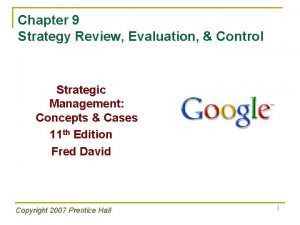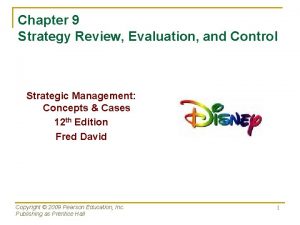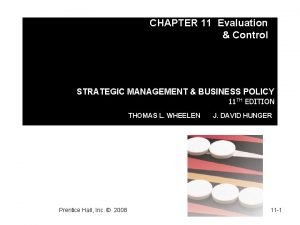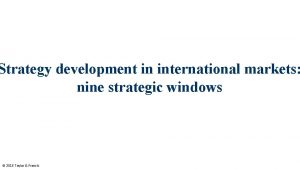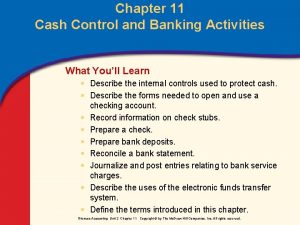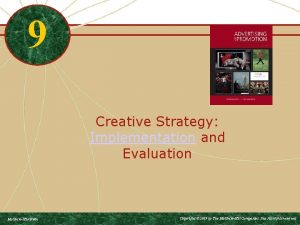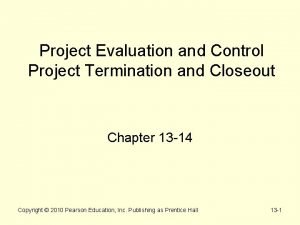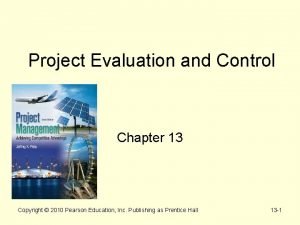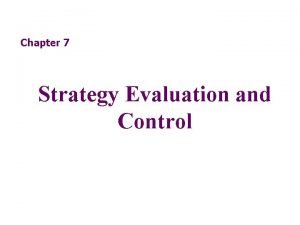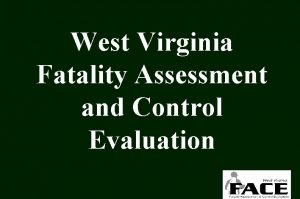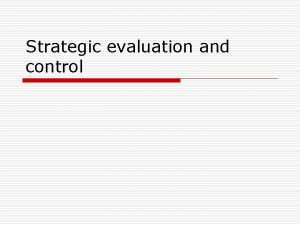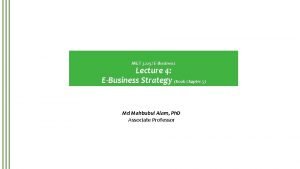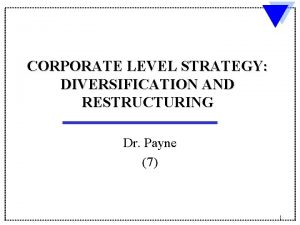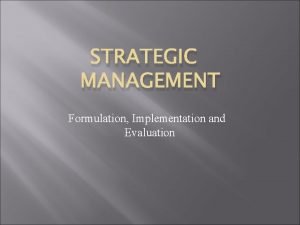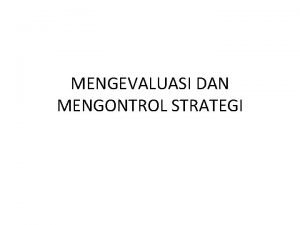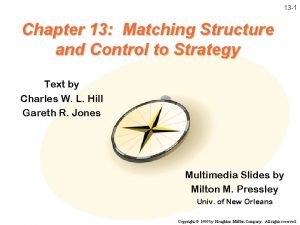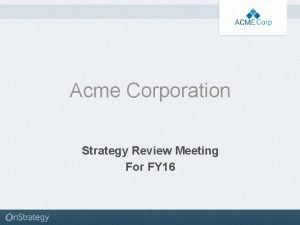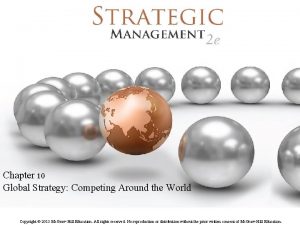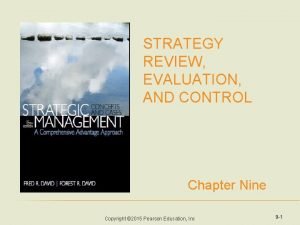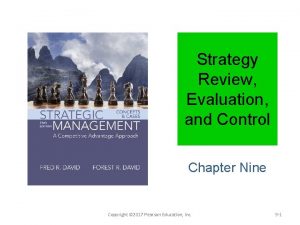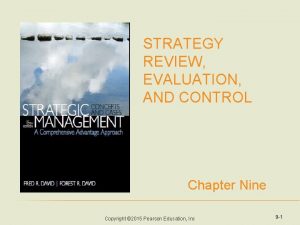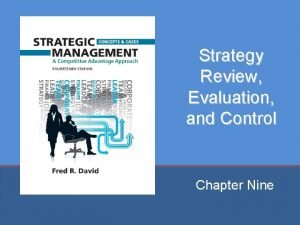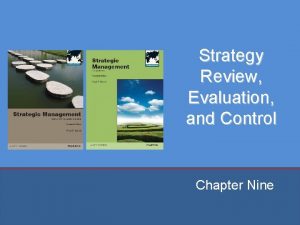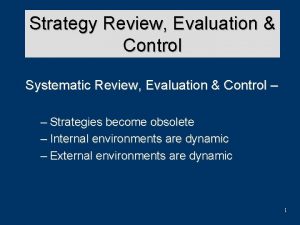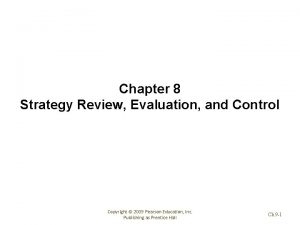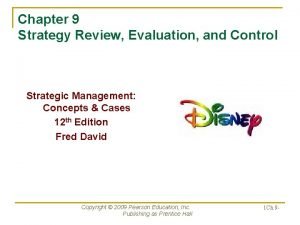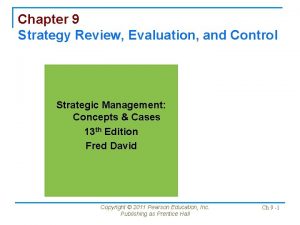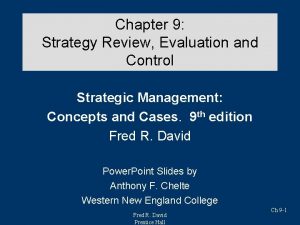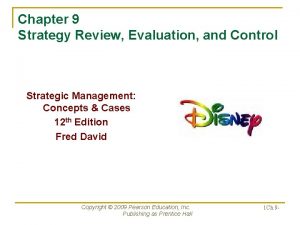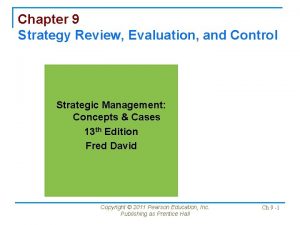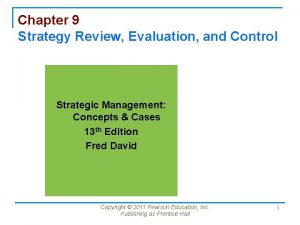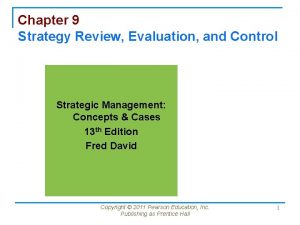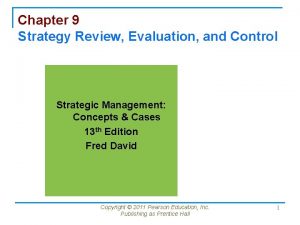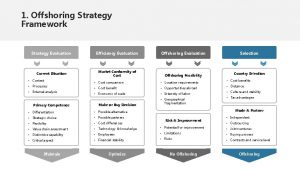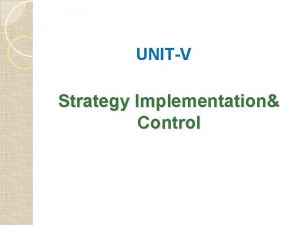Strategy Review Evaluation and Control Chapter Nine Copyright




























- Slides: 28

Strategy Review, Evaluation, and Control Chapter Nine Copyright © 2017 Pearson Education, Inc. 9 -1

Learning Objectives 1. Discuss the strategy-evaluation process, criteria, and methods used. 2. Discuss three activities that comprise strategy evaluation. 3. Describe and develop a Balanced Scorecard. 4. Identify and describe published sources of strategy-evaluation information. 5. Identify and describe six characteristics of an effective strategyevaluation system. 6. Discuss the nature and role of contingency planning in strategy evaluation. 7. Explain the role of auditing in strategy evaluation. 8. Identify and discuss three twenty-first-century challenges in strategic management. 9. Identify and describe 17 guidelines for effective strategic management. Copyright © 2017 Pearson Education, Inc. 9 -2

A Comprehensive Strategic. Management Model Copyright © 2017 Pearson Education, Inc. 9 -3

Strategy Evaluation Three basic activities: 1. Examine the underlying bases of a firm’s strategy. 2. Compare expected results with actual results. 3. Take corrective actions to ensure that performance conforms to plans. Copyright © 2017 Pearson Education, Inc. 9 -4

Strategy Evaluation Criteria Consonance Consistency Advantage Feasibility Copyright © 2017 Pearson Education, Inc. 9 -5

Why Strategy Evaluation is More Difficult Today 1. A dramatic increase in the environment’s complexity 2. The increasing difficulty of predicting the future with accuracy 3. The increasing number of variables 4. The rapid rate of obsolescence of even the best plans Copyright © 2017 Pearson Education, Inc. 9 -6

Why Strategy Evaluation is More Difficult Today 5. The increase in the number of both domestic and world events affecting organizations 6. The decreasing time span for which planning can be done with any degree of certainty Copyright © 2017 Pearson Education, Inc. 9 -7

The Process of Evaluating Strategies v. Strategy evaluation should initiate managerial questioning of expectations and assumptions, should trigger a review of objectives and values, and should stimulate creativity in generating alternatives and formulating criteria of evaluation. Copyright © 2017 Pearson Education, Inc. 9 -8

The Process of Evaluating Strategies v. Evaluating strategies on a continuous rather than on a periodic basis allows benchmarks of progress to be established and more effectively monitored. v. Successful strategies combine patience with a willingness to promptly take corrective actions when necessary. Copyright © 2017 Pearson Education, Inc. 9 -9

Strategy-Evaluation Assessment Matrix 9 -10

A Strategy-Evaluation Framework 9 -11

Reviewing Bases of Strategy 1. How have competitors reacted to our strategies? 2. How have competitors’ strategies changed? 3. Have major competitors’ strengths and weaknesses changed? 4. Why are competitors making certain strategic changes? Copyright © 2017 Pearson Education, Inc. 9 -12

Reviewing Bases of Strategy 5. Why are some competitors’ strategies more successful than others? 6. How satisfied are our competitors with their present market positions and profitability? 7. How far can our major competitors be pushed before retaliating? 8. How could we more effectively cooperate with our competitors? Copyright © 2017 Pearson Education, Inc. 9 -13

Measuring Organizational Performance Strategists use common quantitative criteria to make three critical comparisons: 1. Comparing the firm’s performance over different time periods 2. Comparing the firm’s performance to competitors’ 3. Comparing the firm’s performance to industry averages Copyright © 2017 Pearson Education, Inc. 9 -14

Key Questions to Address in Evaluating Strategies 1. How good is the firm’s balance of investments between high-risk and low-risk projects? 2. How good is the firm’s balance of investments between long-term and shortterm projects? 3. How good is the firm’s balance of investments between slow-growing markets and fast-growing markets? Copyright © 2017 Pearson Education, Inc. 9 -15

Key Questions to Address in Evaluating Strategies 4. How good is the firm’s balance of investments among different divisions? 5. To what extent are the firm’s alternative strategies socially responsible? 6. What are the relationships among the firm’s key internal and external strategic factors? 7. How are major competitors likely to respond to particular strategies? Copyright © 2017 Pearson Education, Inc. 9 -16

Corrective Actions Copyright © 2017 Pearson Education, Inc. 9 -17

The Balanced Scorecard 1. Is the firm continually improving and creating value along measures such as innovation, technological leadership, product quality, operational process efficiencies, and so on? 2. Is the firm sustaining and even improving on its core competencies and competitive advantages? 3. How satisfied are the firm’s customers? Copyright © 2017 Pearson Education, Inc. 9 -18

The Balanced Scorecard v. The Balanced Scorecard approach to strategy evaluation aims to balance longterm with short-term concerns, to balance financial with nonfinancial concerns, and to balance internal with external concerns. Copyright © 2017 Pearson Education, Inc. 9 -19

Characteristics of an Effective Evaluation System v. Strategy evaluation activities must be economical vtoo much information can be just as bad as too little information vtoo many controls can do more harm than good v. Activities should be meaningful vshould specifically relate to a firm’s objectives Copyright © 2017 Pearson Education, Inc. 9 -20

Characteristics of an Effective Evaluation System v. Activities should provide timely information v. Activities should be designed to provide a true picture of what is happening v. Activities should not dominate decisions vshould foster mutual understanding, trust, and common sense Copyright © 2017 Pearson Education, Inc. 9 -21

Contingency Planning v. Contingency Plans can be defined as alternative plans that can be put into effect if certain key events do not occur as expected. Copyright © 2017 Pearson Education, Inc. 9 -22

Contingency Planning v. If a major competitor withdraws from particular markets as intelligence reports indicate, what actions should our firm take? v. If our sales objectives are not reached, what actions should our firm take to avoid profit losses? Copyright © 2017 Pearson Education, Inc. 9 -23

Contingency Planning v. If demand for our new product exceeds plans, what actions should our firm take to meet the higher demand? v. If certain disasters occur, what actions should our firm take? v. If a new technological advancement makes our new product obsolete sooner than expected, what actions should our firm take? Copyright © 2017 Pearson Education, Inc. 9 -24

Effective Contingency Planning 1. Identify both good and bad events that could jeopardize strategies. 2. Determine when the good and bad events are likely to occur. 3. Determine the expected pros and cons of each contingency event. 4. Develop contingency plans for key contingency events. 5. Determine early warning trigger points for key contingency events. Copyright © 2017 Pearson Education, Inc. 9 -25

Auditing v“a systematic process of objectively obtaining and evaluating evidence regarding assertions about economic actions and events to ascertain the degree of correspondence between these assertions and established criteria, and communicating the results to interested users” Copyright © 2017 Pearson Education, Inc. 9 -26

Twenty-First-Century Challenges in Strategic Management v. Deciding whether the process should be more an art or a science v. Deciding whether strategies should be visible or hidden from stakeholders v. Deciding whether the process should be more top-down or bottom-up in their firm Copyright © 2017 Pearson Education, Inc. 9 -27

Guidelines for Effective Strategic Management 1. Keep the process simple and easily understandable. 2. Eliminate vague planning jargon. 3. Keep the process nonroutine; vary assignments, team membership, meeting formats, settings, and even the planning calendar. 4. Welcome bad news and encourage devil’s advocate thinking 5. Do not allow technicians to monopolize the planning process. 6. To the extent possible, involve managers from all areas of the firm. Copyright © 2017 Pearson Education, Inc. 9 -28
 Strategy review evaluation and control
Strategy review evaluation and control Consonance in strategic management
Consonance in strategic management Evaluation and control examples
Evaluation and control examples Strategic windows
Strategic windows Chapter 11 cash control and banking activities
Chapter 11 cash control and banking activities Chapter review motion part a vocabulary review answer key
Chapter review motion part a vocabulary review answer key Transformational advertising
Transformational advertising Project evaluation and control
Project evaluation and control Project evaluation and control
Project evaluation and control Strategy evaluation techniques
Strategy evaluation techniques Fatality assessment and control evaluation
Fatality assessment and control evaluation Strategy evaluation assessment matrix
Strategy evaluation assessment matrix Business strategy evaluation
Business strategy evaluation Business strategy evaluation
Business strategy evaluation Strategy evaluation course
Strategy evaluation course Business strategy vs corporate strategy
Business strategy vs corporate strategy What is an example of chase strategy?
What is an example of chase strategy? Evaluasi dan kontrol manajemen strategi
Evaluasi dan kontrol manajemen strategi International division structure
International division structure Chapter 6 career readiness chapter review answers
Chapter 6 career readiness chapter review answers Ap gov final review
Ap gov final review Nader amin-salehi
Nader amin-salehi What is inclusion and exclusion criteria
What is inclusion and exclusion criteria Narrative review vs systematic review
Narrative review vs systematic review Strategy review meeting
Strategy review meeting Strategy and organization in the international firm
Strategy and organization in the international firm Multidomestic marketing strategy
Multidomestic marketing strategy Aligning hr strategy with business strategy
Aligning hr strategy with business strategy Integration responsiveness grid
Integration responsiveness grid
